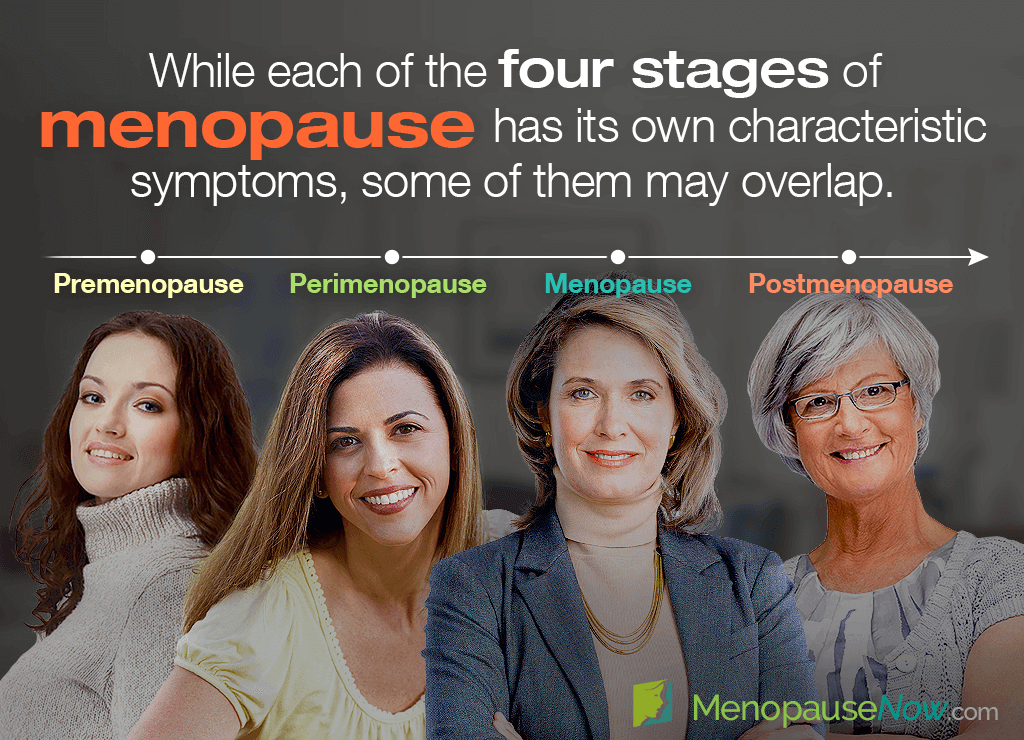Women's reproductive lives transition from stage to stage, from childbearing years that start with puberty and progressing into infertile years, otherwise known as postmenopause. With each stage comes its distinctive list of symptoms.
Continue reading about the four stages of menopause and their symptoms for heightened awareness and better control over your reproductive health.
Premenopause
Premenopause is broadly defined as the first of four menopause stages. It begins with puberty and stops with the first indication of perimenopause.
During premenopause, women have regular periods guided by the reproductive hormones, and they are able to reproduce (as long as they have no fertility issues). Considering that puberty hits in women's early teens, and perimenopause begins in their early- to mid-40s, premenopause lasts an average of 30 to 35 years.
Due to monthly hormonal fluctuations and women's sensitivity to them, it is common to experience premenstrual syndrome (PMS) symptoms in the week or two leading up to menstruation.
Some of the most common are:
- Irritability
- Anxiety
- Headaches
- Abdominal cramps
- Breast tenderness
Up to 150 symptoms have been acknowledged as part of PMS.1
Perimenopause
Perimenopause is the second stage of the four, and it is when a dwindling ovarian reserve begins to take its toll on the female body, causing drastic fluctuations in estrogen and progesterone.
This stage normally lasts an average of four years, but it can also be just a few months or as long as 10 years in length.2,3
Due to the fluctuation of hormones during perimenopause, woman often find their hormonal imbalance symptoms - colloquially called menopause symptoms - to be the most intense.
The most characteristic symptoms are:
Because knowing exactly when you have entered the perimenopause period is difficult, perimenopause tests have been created to help take the guesswork out of it.
Menopause
Once a woman has gone 12 consecutive months without a period, she has officially entered menopause. The average age of menopause in the United States is 51.4
As aforementioned, commonly called “menopause symptoms” are those that happen during perimenopause and can be found in the previous section.
Postmenopause
The day after menopause, a woman is declared in postmenopause.
Unfortunately, many of the aforementioned symptoms experienced during perimenopause can linger into postmenopause. Moreover, consistently low hormone levels may produce the risk of developing more serious health conditions if not addressed promptly. They include:
- Osteoporosis
- Incontinence
- Urinary tract infections
- Heart disease
- Dyspareunia
Aging women can relieve any symptoms and reduce the risk of complications by promoting hormonal health.
Recommendations
Menopause is a difficult transition, but understanding what hormonal changes are occurring is the first step to finding relief. Click on the following link to discover more menopause symptoms treatments to get back to living to your full potential!
Sources
- National Institute on Aging. (2017). What is Menopause? Retrieved November 21, 2019, from https://www.nia.nih.gov/health/what-menopause
Footnotes:
- Society for Endocrinology. (2019). Premenstrual syndrome. Retrieved November 21, 2019, from https://www.yourhormones.info/endocrine-conditions/premenstrual-syndrome/
- Harvard Health Publishing. (2018). Perimenopause: Rocky road to menopause. Retrieved November 21, 2019, from https://www.health.harvard.edu/womens-health/perimenopause-rocky-road-to-menopause
- Cleveland Clinic. (2019). Menopause, Perimenopause and Postmenopause. Retrieved November 21, 2019, from https://my.clevelandclinic.org/health/diseases/15224-menopause-perimenopause-and-postmenopause
- Mayo Clinic. (2017). Menopause: Symptoms & causes. Retrieved November 21, 2019, from https://www.mayoclinic.org/diseases-conditions/menopause/symptoms-causes/syc-20353397




